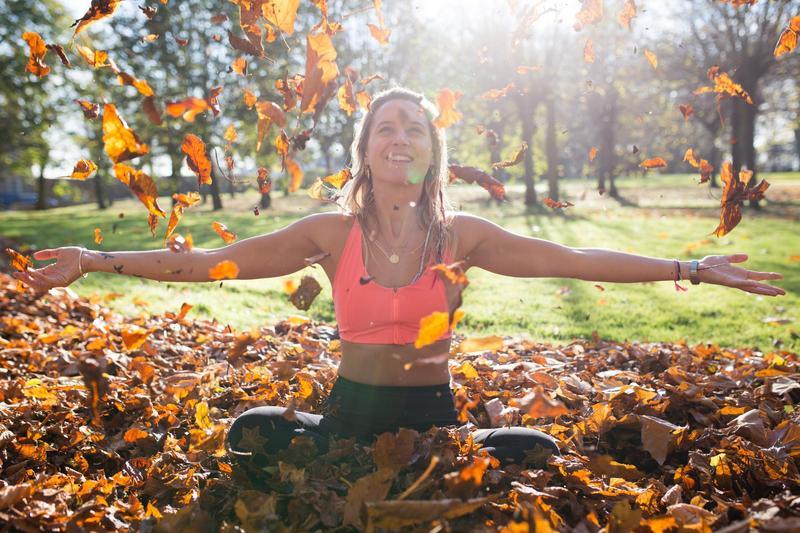Yoga Detox Techniques for Autumn Season: A Detailed Guide
Yoga Detox Techniques for Autumn Season: A Detailed Guide
Detoxing in the fall may sound counterintuitive. After all, spring — Ayurveda’s other optimal time to detox — is our cultural cleaning season, whereas autumn feels like a time to hunker down and get back to work. “In the spring, it’s about shaking off the weight of winter and getting revved up for summer, and we’re good at that,” says Ayurvedic consultant Scott Blossom. “In the fall, it’s about acknowledging that we’re overly busy, slowing down, and restoring the body.”
Ayurveda 101: The Three Doshas
The view in Ayurveda, yoga’s sister science of medicine, is that all of nature—including us—is bound by the relationships among the three doshas, or primal energies.
Vata dosha is associated with the elements air and ether; it governs creativity and change, and tends to wax and wane. Governed by fire and water, pitta dosha is the energy of transformation, achievement, and metabolism. Kapha dosha is associated with earth and water; it suggests groundedness, stability, and growth.
Don’t know your dosha? Take this quiz to find out.
Why Autumn Is the Perfect Time for an Yoga Detox
Each of us contains a unique mix of the three doshas, although we tend to be dominated by one at any given time. The seasons are also governed by doshic activity. According to Ayurvedic theory, by the time autumn rolls around, we have accumulated plenty of heat in our tissues from the summer—that’s fiery pitta dosha. As the leaves dry up and the wind begins to blow, vata dosha begins to take over—the one governed by air and marked by change, instability, and anxiety. Metaphorically speaking, what happens when you add random blasts of air to a fire? It burns even brighter. Blossom says that when the accumulated heat of pitta is fanned by vata, it can lead to mental and physical burnout, stressing our adrenals and nervous system and putting some of the body’s natural detoxification processes on hold.
Consider the liver, for example. It is the body’s natural detoxifier and one of the primary organs in which excess pitta can accumulate and cause problems. According to Claudia Welch, an Ayurvedic practitioner and the author of , the liver processes not only the foods and drinks we ingest but also many of the chemicals we encounter on a daily basis—from prescription and over-the-counter medications to hand soap to particulate matter in the air. And when the liver gets overloaded with excess pitta (which puts stress on the liver), so do we. An overtaxed liver can result in migraines, irritability, rashes, anger, and more. “We get tired, we get sick, we gain or lose too much weight,” she says. As the two systems in the body designed to “transform” toxins—the liver and the digestive tract—become overwhelmed, we start to collect a kind of toxic sludge made up of all the waste products that the body has not been able to properly break down, digest, or otherwise expel.
The toxins our body cannot process have a name in Ayurveda: ama (Sanskrit for “that which harms or weakens”). Ayurvedic physician Robert Svoboda characterizes ama not only as a kind of physical sludge, but also as a psychosomatic sludge that pollutes the mind. Accumulated ama is the basis for much disease and emotional malaise—and from a physical standpoint, it creates an appealing host environment for cold and flu viruses that blow in on autumn’s winds.
Do You Really Need to Detox?
Think you don’t have to worry about ama? Not so fast. We all do, Svoboda says, as a result of poor diet choices, unhealthy lifestyle habits—even just living and breathing in a polluted world. “Pretty much no matter who you are, you’ll end up with ama,” he says. “The question you have to ask yourself is, ‘What do I do about it?’”
4-Step Yoga Detox
To protect your health year round, but particularly during the fall, Ayurvedic health educators say it’s important to slow down, support your liver’s natural ability to remove toxins from the body, and take stock of the influences that you allow into your life—from the kind of food you eat to the amount of time you spend in front of an electronic device (computer, cell phone, TV).
Unlike some popular cleanses that ask you to undergo dramatic fasts or to take other extreme measures, purvakarma (which literally means “up-front actions”) is designed to support, instead of shock, your system. “Rather than aiming to eliminate toxins at any cost, purvakarma gently balances the whole person so that they can detox without destabilizing the body in any way,” Blossom explains. “It is a middle-path cleanse that uses nourishing foods, herbs, and self-care techniques to rejuvenate the body rather than simply strip it down, which can leave you even more vulnerable going into winter.”
Blossom says that a middle-path method of cleansing includes a simplified diet, yoga asana, self-massage, nasal irrigation, herbs, meditation, pranayama, and reflection. During the cleanse, you’ll forgo substances and habits that contribute to liver overload—such as processed foods or alcohol—and the unaddressed stress that strains your nervous system. You’ll also spend time thinking about what influences you want to keep in your life and what you might want to let go. “The key to purvakarma is that it’s a suspension of bad habits,” Blossom explains. “Only then can you have space to establish the good habits you need to create the kind of health and vibrancy you want for your life.”
Step 1: Slowing Down
Reducing stress and mental overactivity is perhaps the most important element of a successful detox plan, Blossom says. Habitual rushing, multitasking, and dealing with information overloads are the trifecta of American toxicity. And like an overtaxed liver, an overtaxed mind and nervous system can lead to a host of health issues, including adrenal fatigue, insomnia, irregular menstrual cycles, indigestion, and unwelcome weight gain.
The first step in reducing the toxicity created by an overloaded life? Slowing down. During the next seven days, adjust your schedule so you have time to prepare and eat your meals in a relaxed manner, practice daily yoga, and take regular meditation breaks. By saying “no” to the outside influences that pull your attention and energy in so many directions—and replacing them with healthier choices—you’ll begin to tune in to your body’s natural rhythms and detox more effectively.
Step 2: Detox Diet
Next, you need to nourish your body with healthful, cleansing foods. At the heart of the dietary program is kitchari, a simple dish of rice and mung beans widely used throughout Asia to purify the body. Its balance of protein, carbohydrates, and fat makes for an easy-to-digest yet highly nourishing meal. Kitchari is also tridoshic, which means that it’s appropriate for all three doshas. “The lightness of the dish reduces kapha in the body,” Blossom says. “At the same time, it stabilizes vata by offering a complete source of protein. And the astringent nature of the beans cools pitta, so kitchari is naturally anti-inflammatory.” Best of all, eating kitchari twice daily keeps hunger and cravings at bay, he says.
Ayurvedic cleansing also calls for ghee (clarified butter), which lubricates the digestive tract and facilitates the elimination of toxins from the body. Spicy teas and chutneys are recommended to keep the fires of digestion stoked throughout the cleanse; and triphala, a traditional Ayurvedic digestive tonic (made up of three fruits—amalaki, bibhitaki, and haritaki) with antioxidant properties, acts as a mild laxative. “Triphala is a classic example of an Ayurvedic remedy that supports the system and preserves what is good while it gets rid of toxins that will sicken the body,” Blossom explains. “Taken together, all parts of this plan make sure you’re getting everything you need to stay healthy and you won’t be malnourished in any way.”
Step 3: Cleansing Yoga
Specific yoga poses can help expedite the detoxification process. The heating and twisting sequences designed for this plan can help move toxins from your tissues through your lymphatic and digestive systems so that they can be eliminated from the body. In addition, restorative poses, relax the nervous system and mind and help settle the body—which is especially important during and after a detox cleanse. Restorative poses will also help bring you into a state of receptivity that’s perfect for the season, says New Jersey yoga teacher and restorative teacher trainer Jillian Pransky. “I look at autumn as a transition into a new year,” she says. “I look at nature: The harvest is over, and it’s time to clear out. It’s an opportunity to till the soil and plant the seeds for next year’s harvest. Once we do this for ourselves, we can recommit to what is working for us and set ourselves up to get more of what nourishes us in our lives.”
Step 4: Self-Study
As you go through the program, contemplate the ultimate question: “Why am I doing this?” By interrupting your normal patterns, cleansing provides a unique opportunity to practice svadhyaya, self-study. No matter what your motivation is—better health, a simpler life, a deeper yoga practice—you’ll be amazed at the insights you can gain when you just slow down and start to listen.“The body should be telling us all the time what to do and what not to do—it knows what’s good for it and what is not,” Svoboda says. “The key is to get out of your own way.” And that is the point, says Blossom. “At the end of the cleanse, you should take a day to meditate and observe and to ask yourself: ‘What are the things I’m doing to make my life the best it can be? What things am I doing to sabotage myself?’”
During a detox, Blossom encourages taking time to contemplate not only what you want for your own life but also what you want to put out into the world. If you can, pass a half or a full day in silence, and spend time in nature or journaling about your experience. Did the cleanse give you clarity about how you may be exerting energy in ways that don’t serve you, and where you can use that energy more effectively, perhaps even to help a larger cause?
Get clear on the answers, and your life will get simpler: Do what works; don’t do what doesn’t. “When you temporarily change your daily routines, you open yourself up to seeing and feeling from new perspectives,” Blossom says.
Scott Blossom’s Detoxifying Restorative Yoga Sequence
As you go through the Fall Detox program, you will be practicing yoga sequences that are designed to heat the body and facilitate the removal of waste and toxins. Make time for relaxation and restorative yoga to support the body during this process.
Practice the following restorative sequence daily during the program and plan to do an extended version of it on the last day of your cleanse.
These poses are designed to relax the nervous system and mind. There are a lot of props involved; they will allow you to sink deeply and deliciously into yourself. In each pose, you can also cover yourself with a blanket for greater comfort. Spend at least three to five minutes in each pose. As you become more comfortable with them, you can stay longer.
Practice with the video: Restorative Detox Practice
Props:
1 yoga mat
1 bolster
1 yoga strap
1 sandbag or equivalent (such as a bag of sugar or rice)
4 blankets
1 eye pillow or equivalent (a towel or a piece of lightclothing, like a shirt)
1. Salamba Viparita Karani (Supported Legs-Up-the-Wall Pose)

Set your mat vertically against a wall and place a bolster across it horizontally. Fold a blanket to the size of a bed pillow; then fold it again two-thirds of the way down so you have a thinner edge (for your neck) and a thicker edge (for your head). Sit on the bolster with your left hip against the wall. Tip back as you turn your legs up the wall, and lower yourself so that your middle and upper back are on the mat, and your head and neck are on the blanket, forehead slightly higher than your chin. Bend your knees and put your feet through a loop in the strap, tightening it gently around your shins, and reset your legs up the wall. Place another blanket across your torso and a sandbag on your pelvis. Put the eye pillow over your eyes and rest your hands by your sides.
2. Supported Sidebend

Sitting with your right hip against the bolster, lean to the right, placing your right hand on the far side of the mat as you lower down. Stretch your right arm straight along the ground and rest your head on your biceps. Then stretch your left arm overhead and place your palms together. With each exhalation, relax your entire body, paying special attention to your neck. When you’re ready to switch sides, slowly turn your body facedown, and then gently press your hands into the ground to rise up. Repeat on the other side, and then take Child’s Pose for a few breaths.
3. Salamba Mandukasana (Supported Frog Pose), detox variation

4. Salamba Bharadvajasana (Supported Bharadvaja’s Twist), detox variation

Put a folded blanket at the bottom end of the bolster and sit with your left hip against the edge of the blanket. Turn from your belly toward the bolster, placing your hands on either side, and lean down slowly until your forehead touches. Turn your head to the right, tucking your chin slightly. Keep the back of the neck long and the front of the throat soft. Finally, place the eye pillow across the nape of your neck and rest your hands and forearms along the floor. Allow your breath to slow down and deepen; observe how your inhalations root your pelvis and gently enhance the turning sensation in the belly and shoulders. When you’re ready, change sides.
5. Salamba Supta Baddha Konasana (Supported Reclining Bound Angle Pose)

Prepare a pillow as you did for the first pose and place it on the top end of the bolster. Sit with your back to the bolster; bring the soles of your feet together; and let your knees drop open, positioning a rolled blanket under each one. Lay a sandbag across your feet, and, using your hands behind you on the mat, slowly lower down onto the bolster. Adjust the head blanket
so your forehead is higher than your chin, place an eye pillow over your eyes, and rest your hands on the ground. Allow your breath to slow down and deepen. With each exhalation, allow your abdomen to soften as much as possible.
Source: The Yoga Journal
Be the first to post a message!
